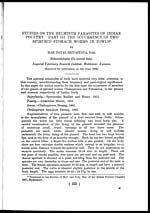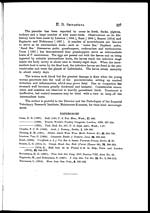Medicine - Veterinary > Veterinary colleges and laboratories > Indian journal of veterinary science and animal husbandry > Volume 9, 1939 > Original articles > Studies on the helminth parasites of Indian poultry. Part III. The occurrence of two spirudid stomach worms in fowls
(118) Page 226
Download files
Individual page:
Thumbnail gallery: Grid view | List view

226 Helminth Parasites of Indian Poultry
This round-worm occurs in the gizzard of fowl and turkey in a number
of countries: North and South America, Australia, France, Italy and Russia.
The eggs are passed out with the faeces and hatch in the gut of the interme-
diate host, which according to Cram is a grasshopper. The larvae reach the
infective stage inside the grasshopper in about twenty-five days. The final
host acquires infection through, eating infected grasshoppers. In fowls the
worms force their way through the horny lining of the gizzard, usually in the
anterior part of the organ where the lining is softest. For a period of nineteen
days they remain on the surface of the muscular wall, under the lining. Be-
tween the 20th and 25th day they start to penetrate the wall and are found
with their heads embedded .in the muscles of the gizzard. Later on in
about seventy-six days, they attain sexual maturity and are located in cir-
cumscribed nodules with caseous contents.
These parasites produce soft nodules in the musculature of the gizzard
and thereby weaken it. They have some toxic effect on the host too. In
heavy infestations they produce emaciation, droopiness, weakness and anaemia.
The gizzard lining may be haemorrhagic and necrotic and the wall flabby.
Sometimes the gizzard is weakened to such an extent that a rupture in the form
of a large sac occurs. Owing to the location of the parasite in the final host
and the migratory habits of its intermediate host, treatment and prophylaxis
are obviously difficult.
Family.—Tetrameridae Travassos, 1914.
Genus.— Tetrameres Creplin, 1846.
Tetrameres fissipina Diesing, 1861.
Members of the genus Tetrameres and of related genera are unique among
nematodes in presenting marked sexual dimorphism. The females after co-
pulation enter the glands of the proventriculus and become globular in shape,
due to distension with eggs and are blood red in colour. The globular female
has two small projections on opposite sides, the cephalic and the caudal pro-
jections. The males, on the other hand, retain throughout life the usual elong-
ate and cylindrical nematode form and are found free in the lumen of the pro-
ventriculus. The fertilization usually takes place in the lumen of the pro-
ventriculus, though at times the males are known to follow the females into
the gland temporarily for copulation. The female comes to lie in the gland in
such a position that the tail protrudes into the duct of the gland to facilitate
the passage of the eggs, and the head is in the fundus of the gland to facilitate
feeding.
From a private communication from Mr. F. Ware, it is learnt that this
parasite occurs in certain Indian birds in the Madras Presidency, but it has
not been recorded so far. The parasite was first recovered from the proven-
triculus of a fowl in 1936. Subsequently it has been found to be a very common
parasite in a number of ducks received from Peshawar. In their morphological
and anatomical characters, the specimens conformed to Cram's description of
T. fissipina.
Set display mode to: Large image | Zoom image | Transcription
Images and transcriptions on this page, including medium image downloads, may be used under the Creative Commons Attribution 4.0 International Licence unless otherwise stated. ![]()
| Permanent URL | https://digital.nls.uk/75246790 |
|---|
| Description | Covers articles from 1939. Please note that pagination starts at p.139 and plates at Plate V. |
|---|




